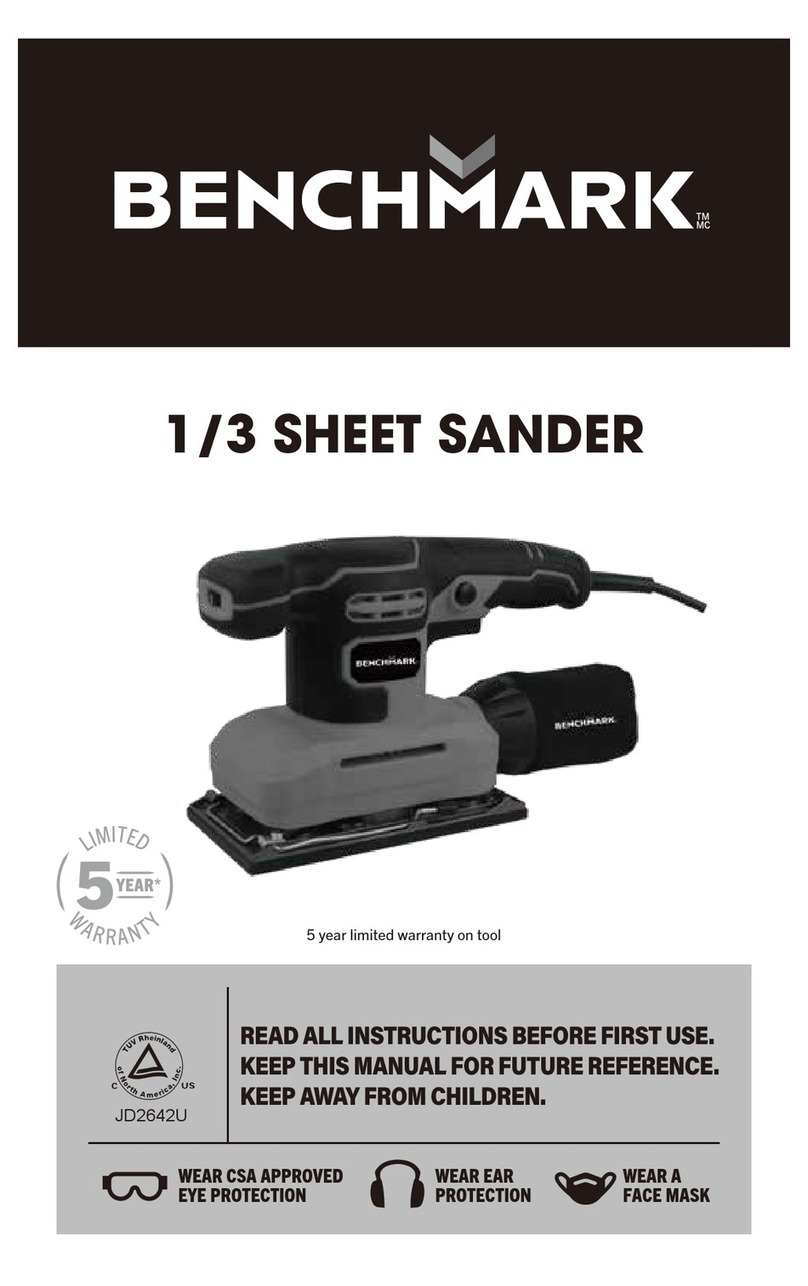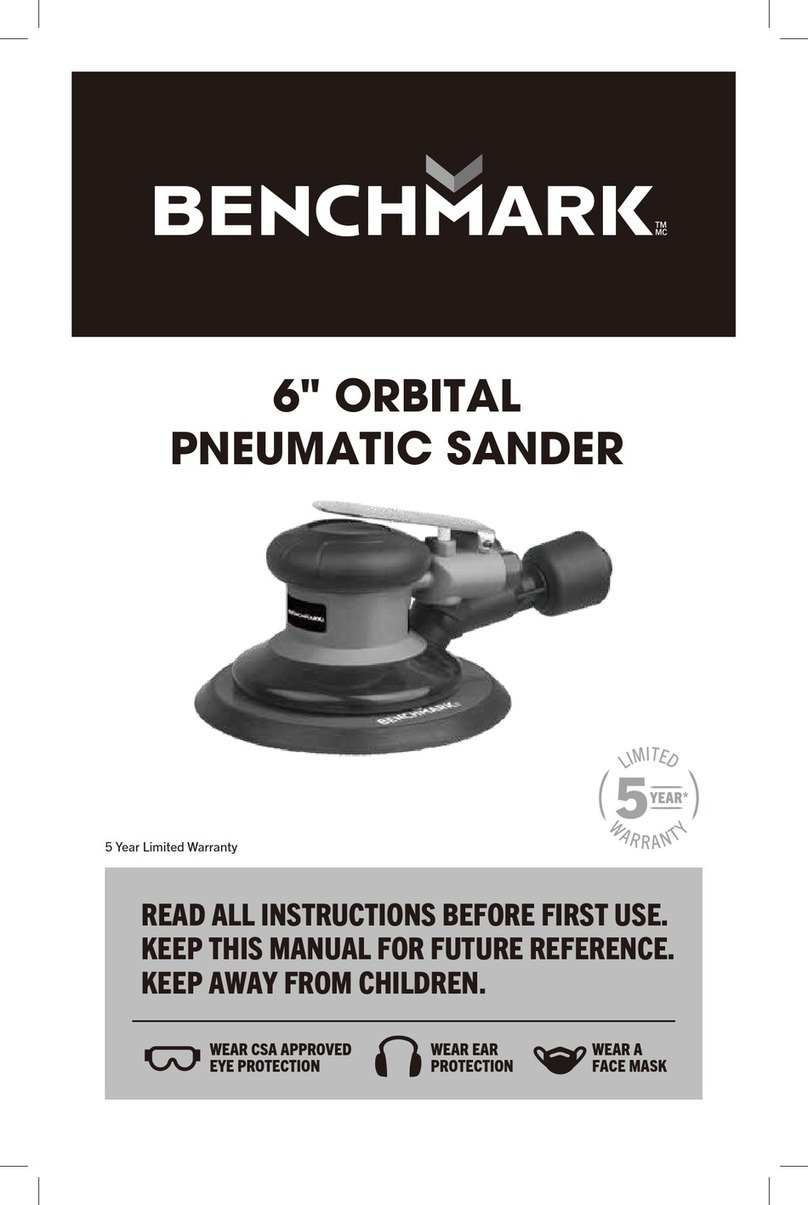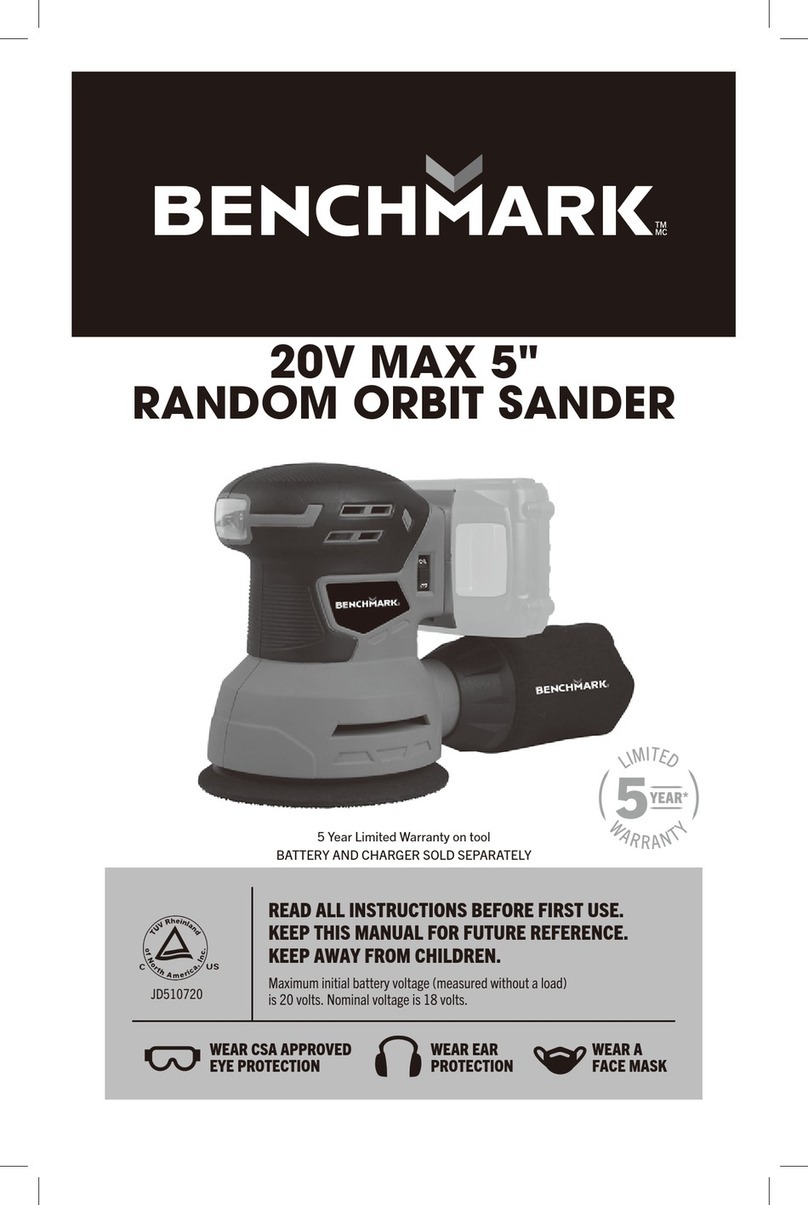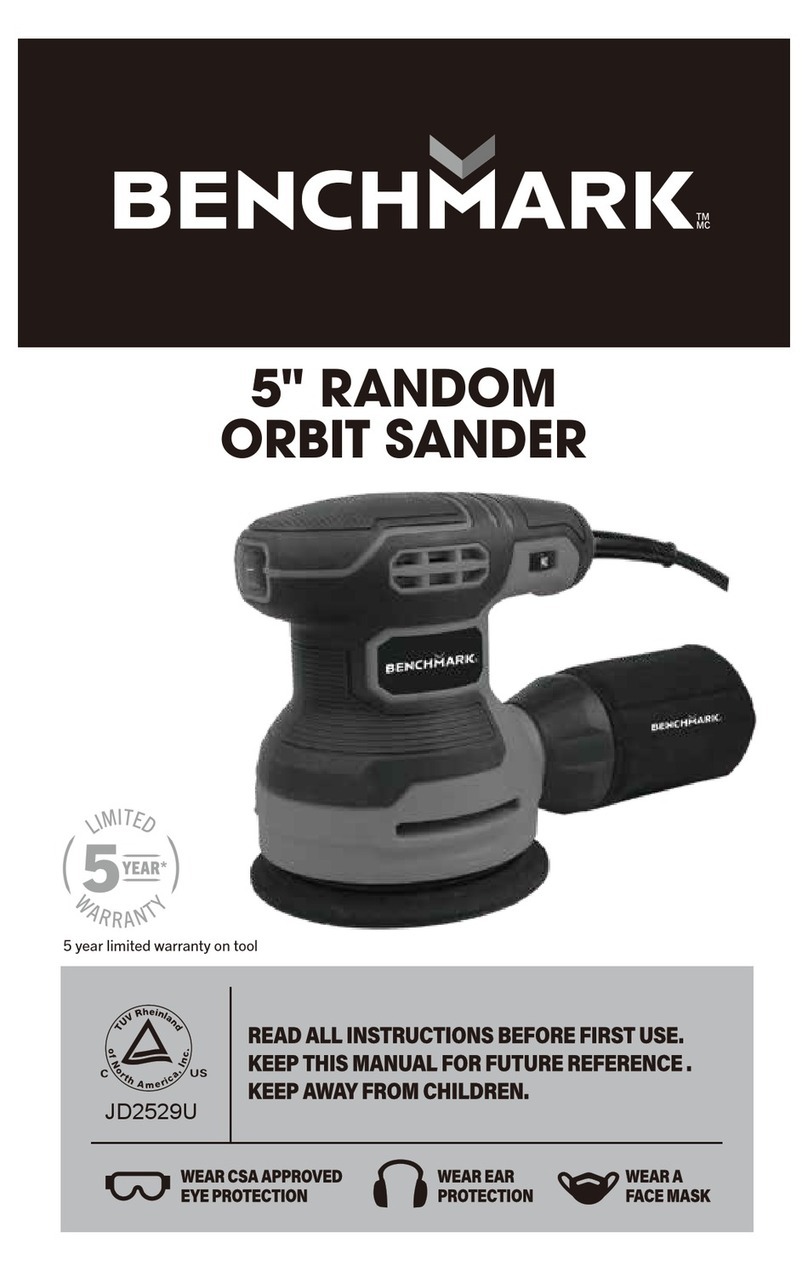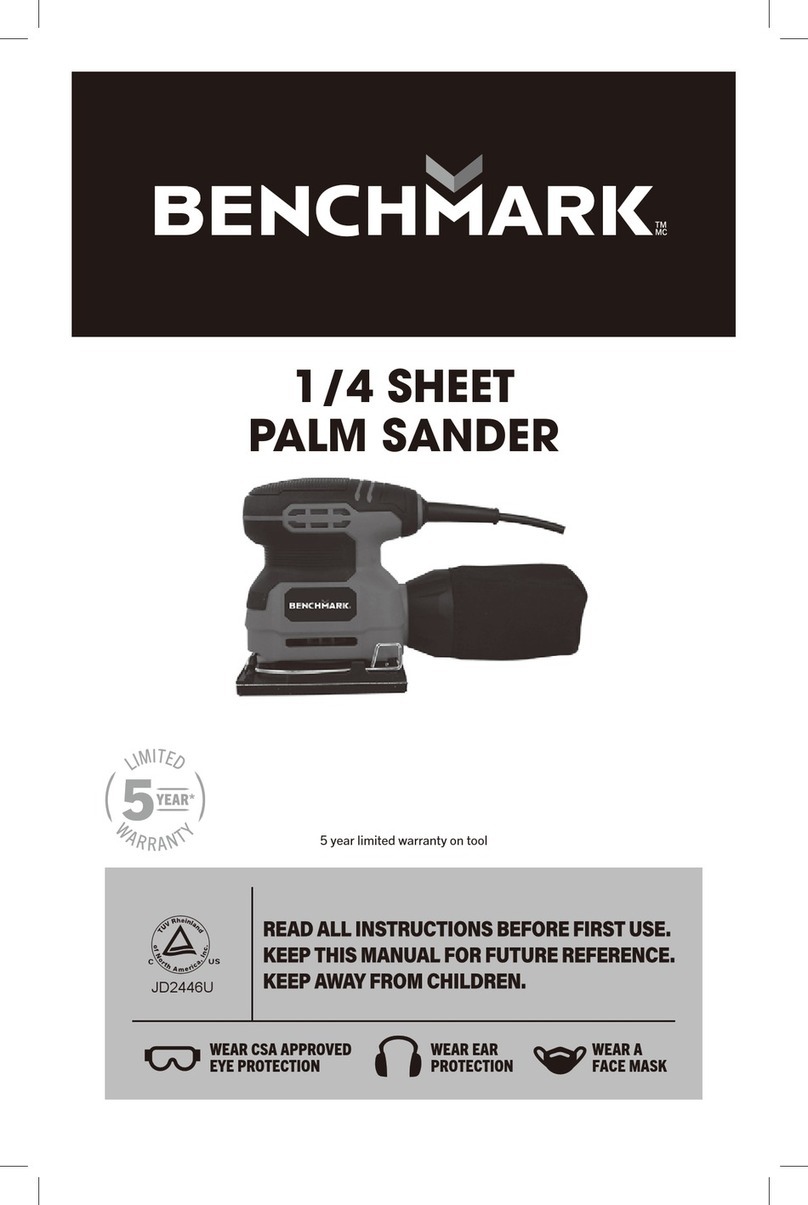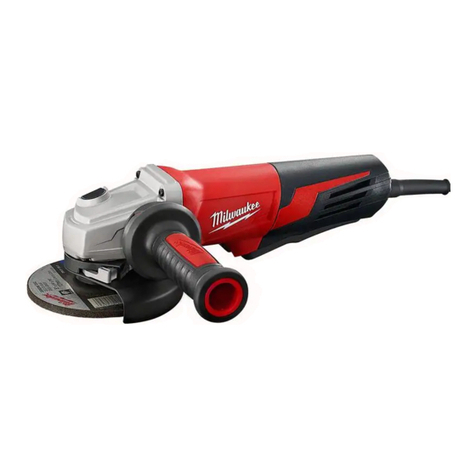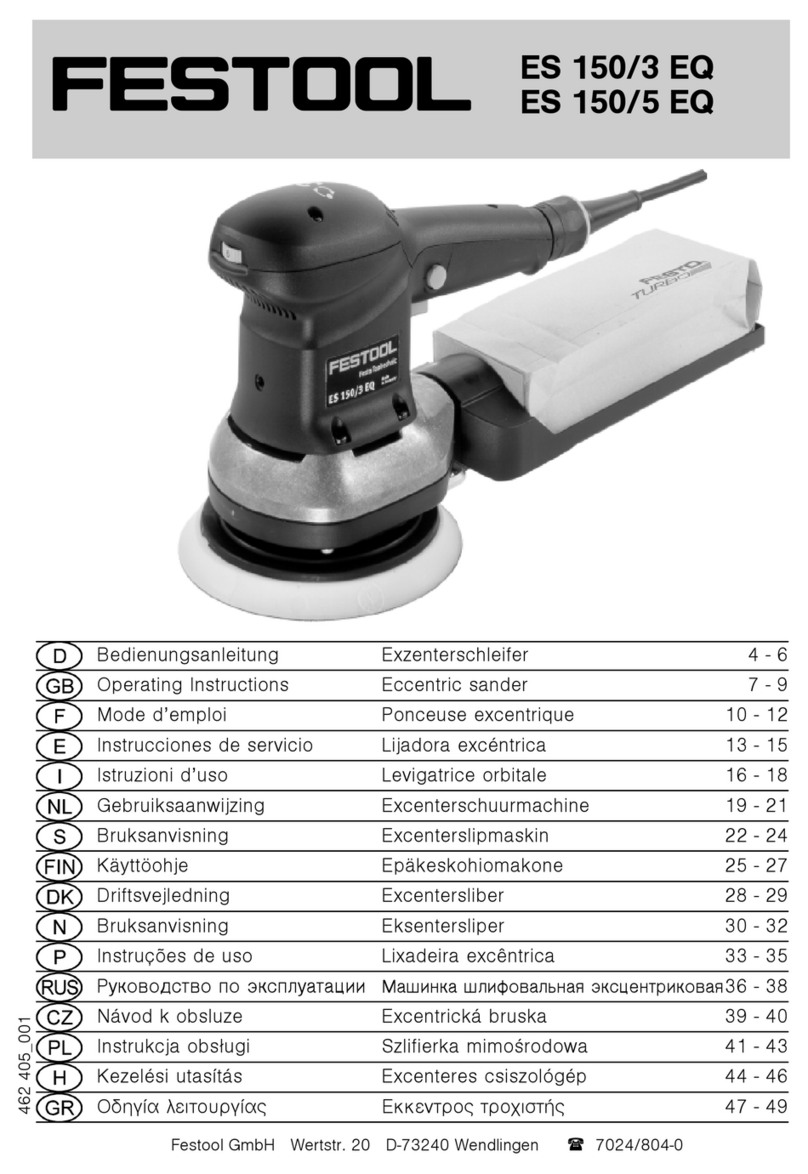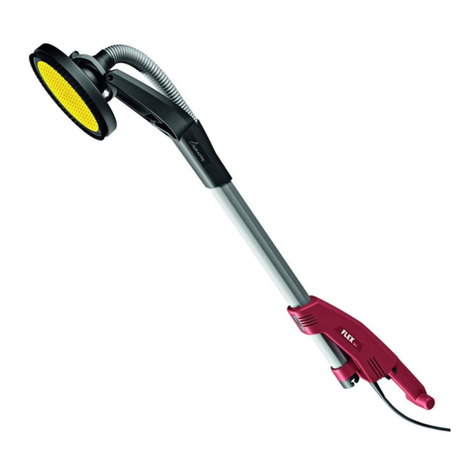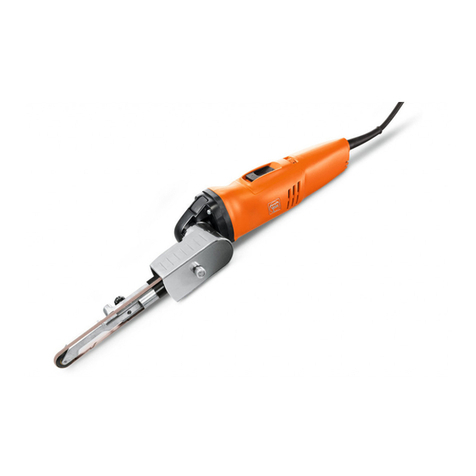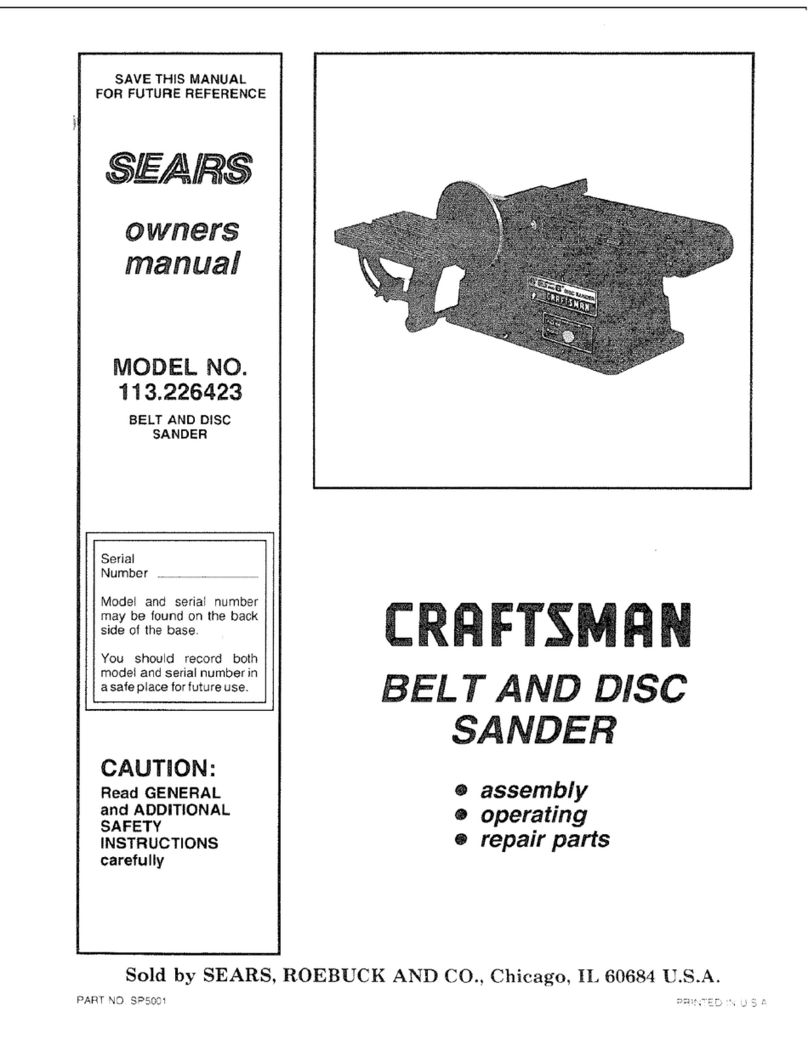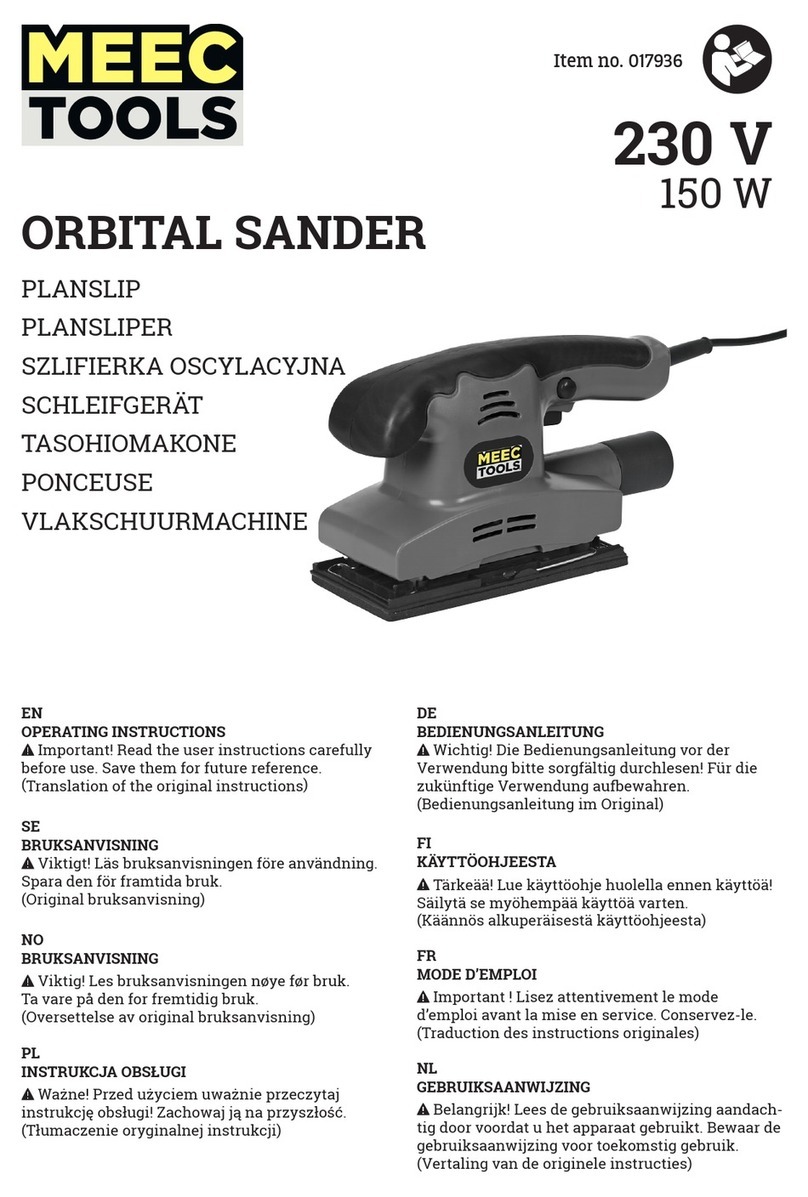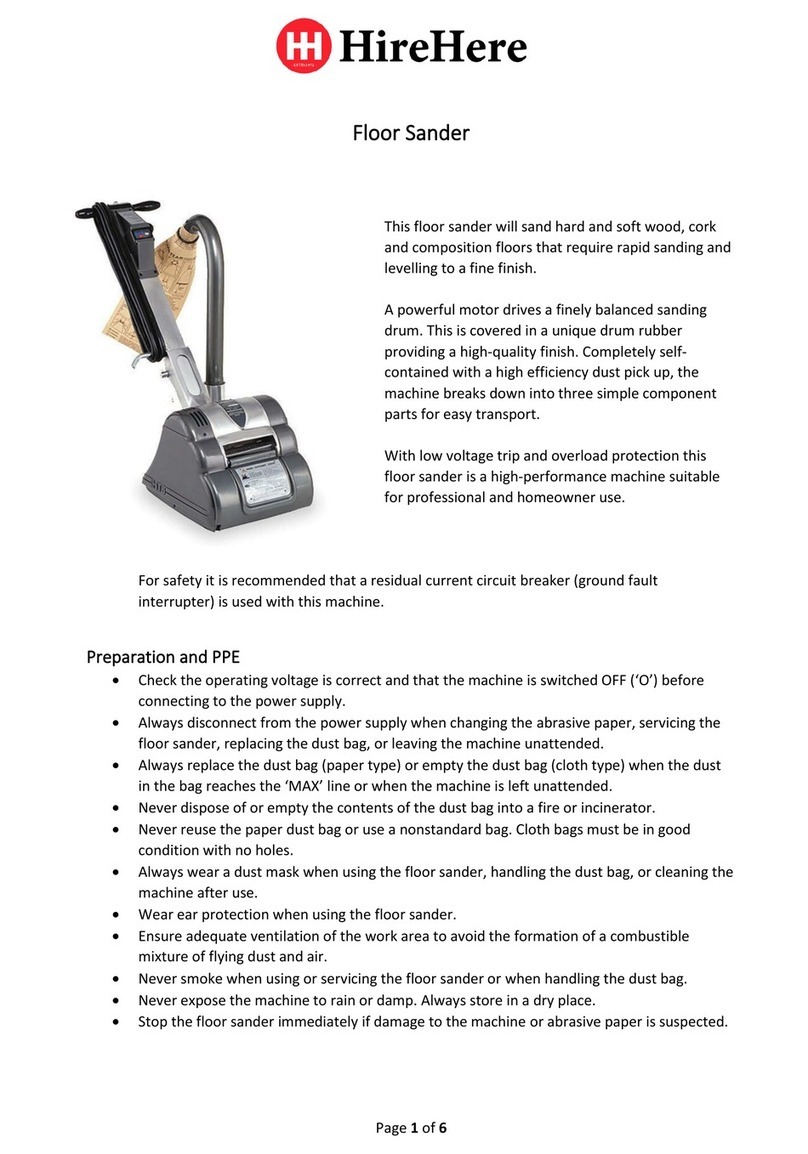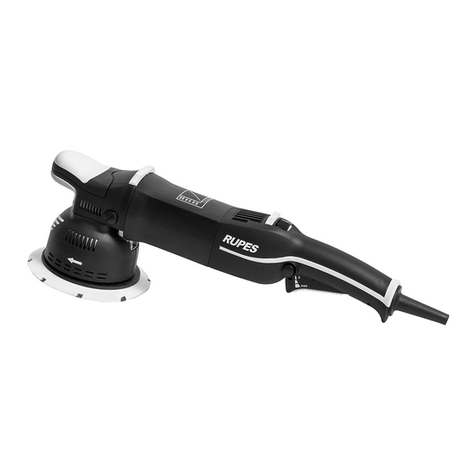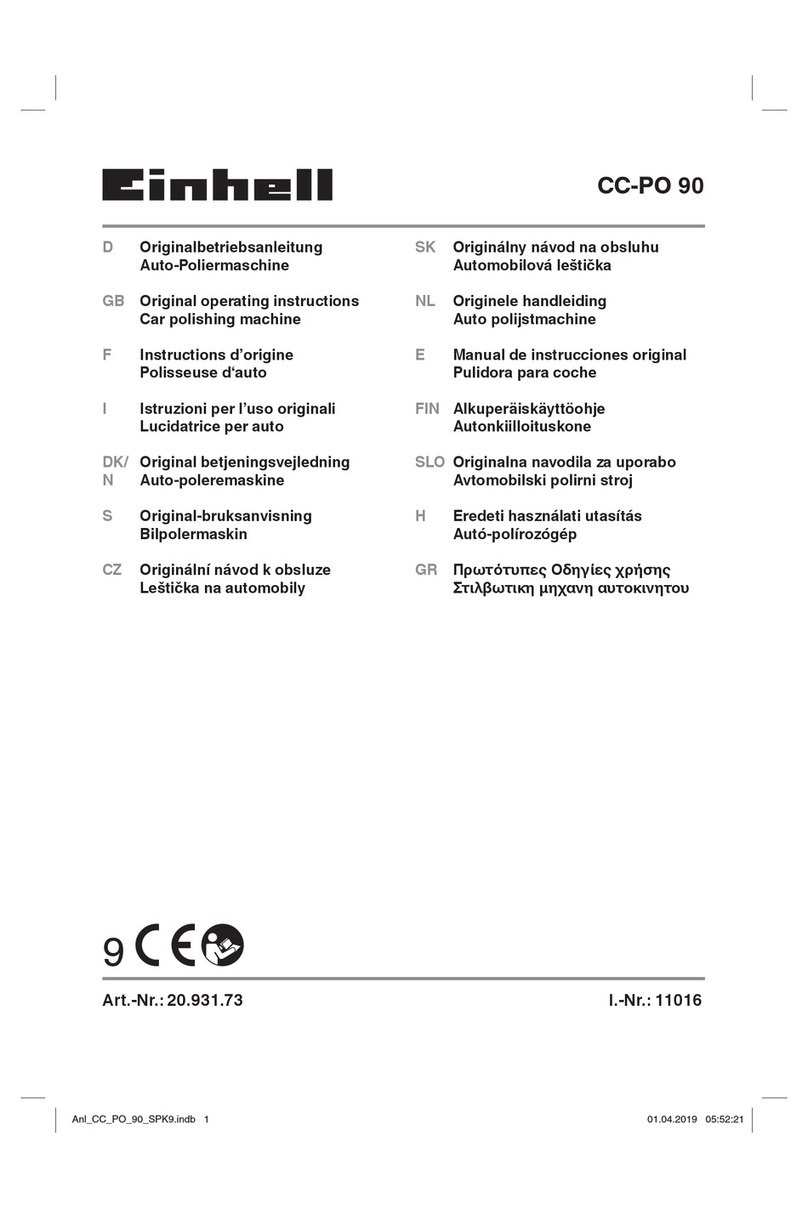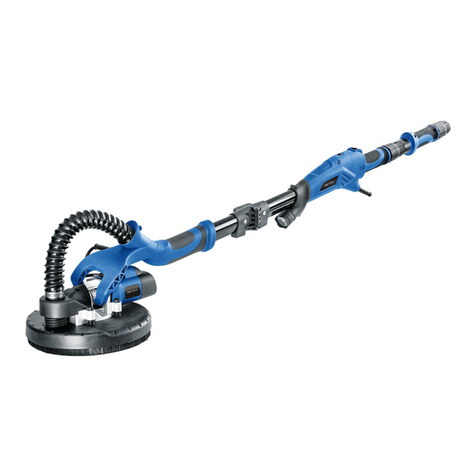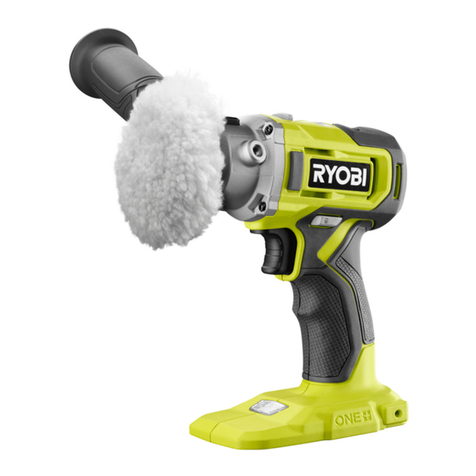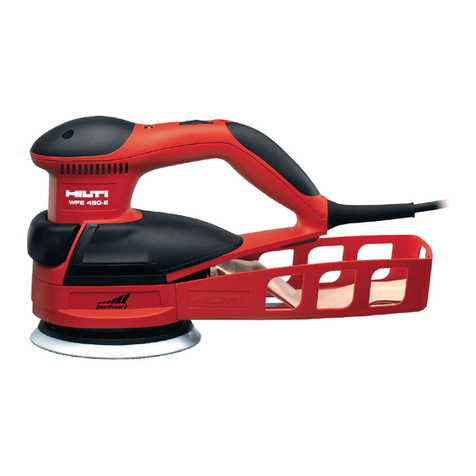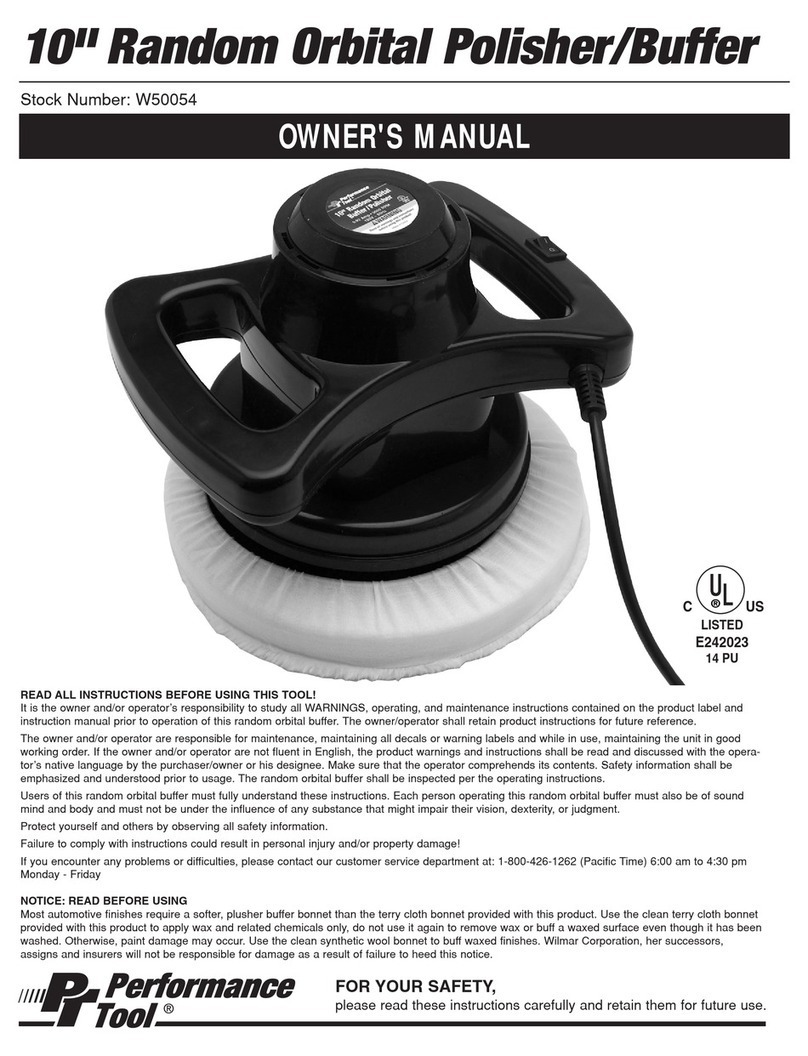Benchmark 1262-200 User manual

READ ALL INSTRUCTIONS BEFORE FIRST USE.
KEEP THIS MANUAL FOR FUTURE REFERENCE.
KEEP AWAY FROM CHILDREN.
WEAR CSA APPROVED
EYE PROTECTION
WEAR EAR
PROTECTION
WEAR A
FACE MASK
3042597
JD2442U
DETAIL SANDER
5 Year Limited Warranty on tool

1
PRODUCT SPECIFICATIONS
2A DETAIL SANDER
Rating: 120V, 60Hz, AC
Amperes: 2 Amp
Speed: 13,000 OPM (no load)
Sanding pad size: Detail sanding base:
5.8” x 5.8” x 3.3” (148 x 148 x 84 mm)
Detail sanding attachment:
3.5” x 3.5” x 3.5” (90 x 90 x 90 mm)
Finger sanding attachment:
3.6” x 1.2” (91 x 30 mm)
Tool weight: 2.6 lbs (1.17 kg)
NEED ASSISTANCE?
Call us on our toll-free customer support line:
1-866-349-8665 (Monday through Friday 9am – 5pm Eastern Standard Time)
• Technical questions
• Replacement parts
• Parts missing from package

1262-200
DETAIL SANDER
2
TABLE OF CONTENTS
Product specifications ................................................................................... 1
Table of contents ........................................................................................... 2
General safety warnings ................................................................................. 3
Eye, ear & lung protection .............................................................................. 3
Electrical safety ............................................................................................ 4
Power tool safety............................................................................................ 4
General safety rules ....................................................................................... 4
Work area ...................................................................................................... 4
Electrical safety ............................................................................................. 5
Personal safety .............................................................................................. 5
Power tool use and care ................................................................................. 5
Service .......................................................................................................... 5
Specific safety rules....................................................................................... 6
Extension cord safety..................................................................................... 7
Symbols......................................................................................................... 8
Know your detail sander................................................................................. 9
Assembly and operating............................................................................... 10
Installing the dust box assembly................................................................... 11
Cleaning the dust box................................................................................... 11
Installing sandpaper .................................................................................... 11
Sandpaper selection and changing sanding plates........................................ 11
Fitting sanding sheets .................................................................................. 13
ON/OFF switch ............................................................................................ 13
Sanding ....................................................................................................... 13
Maintenance ............................................................................................... 14
Exploded view.............................................................................................. 15
Parts listing.................................................................................................. 16
Warranty...................................................................................................... 18

3
GENERAL SAFETY WARNINGS
WARNING:
Before using this tool or any of its accessories, read this manual and follow all Safety
Rules and Operating Instructions. The important precautions, safeguards and
instructions appearing in this manual are not meant to cover all possible situations.
It must be understood that common sense and caution are factors which cannot be
built into the product.
This instruction manual includes the following:
• General Safety Rules •Specific Safety Rules and Symbols
• Functional Description •Assembly
• Operation •Maintenance
• Accessories
SYMBOL MEANING
ALWAYS WEAR EYE PROTECTION THAT CONFORMS WITH CSA
Z94.3 or ANSI SAFETY STANDARD Z87.1
FLYING DEBRIS can cause permanent eye damage. Prescription
eyeglasses ARE NOT a replacement for proper eye protection.
Non-compliant eyewear can cause serious injury if broken during
the operation of a power tool.
Use hearing protection, particularly during extended periods of
operation of the tool, or if the operation is noisy.
WEAR A DUST MASK THAT IS DESIGNED TO BE USED WHEN
OPERATING A POWER TOOL IN A DUSTY ENVIRONMENT.
Dust that is created by power sanding, sawing, grinding, drilling, and
other construction activities may contain chemicals that are known to
cause cancer, birth defects, or other genetic abnormalities.
These chemicals include:
• Lead from lead-based paints
• Crystalline silica from bricks, cement, and other masonry products
• Arsenic and chromium from chemically treated lumber.
The level of risk from exposure to these chemicals varies, according to
how often this type of work is performed. In order to reduce exposure
to these chemicals, work in a well-ventilated area, and use approved
safety equipment, such as a dust mask that is specifically designed to
filter out microscopic particles.
To avoid electrical hazards, fire hazards or damage to the tool,
use proper circuit protection.
This tool is wired at the factory for 120 Volts AC operation. It must be
connected to a 120 Volts AC, 15 Amps circuit that is protected by a
time-delayed fuse or circuit breaker. To avoid shock or fire, replace
power cord immediately if it is worn, cut or damaged in any way.

1262-200
DETAIL SANDER
4
GENERAL SAFETY RULES
WARNING: Read all safety warnings and all instructions. Failure to follow the
warnings and instructions may result in electric shock, fire and/or serious injury.
Save all warnings and instructions for future reference.
WORK AREA SAFETY
Keep work area clean and well lit. Cluttered or dark areas invite accidents.
Do not operate power tools in explosive atmospheres, such as in the presence
of flammable liquids, gases or dust. Power tools create sparks which may ignite
the dust or fumes.
Keep children and bystanders away while operating a power tool. Distractions can
cause you to lose control.
ELECTRICAL SAFETY
Power tool plugs must match the outlet. Never modify the plug in any way.
Do not use any adapter plugs with earthed (grounded) power tools. Unmodified
plugs and matching outlets will reduce risk of electric shock.
Avoid body contact with earthed or grounded surfaces such as pipes, radiators,
ranges and refrigerators.There is an increased risk of electric shock if your body is
earthed or grounded.
Do not expose power tools to rain or wet conditions. Water entering a power tool
will increase the risk of electric shock.
Do not abuse the cord. Never use the cord for carrying, pulling or unplugging
the power tool. Keep cord away from heat, oil, sharp edges or moving parts.
Damaged or entangled cords increase the risk of electric shock.
When operating a power tool outdoors, use an extension cord suitable
for outdoor use. Use of a cord suitable for outdoor use reduces the risk of
electric shock.
If operating a power tool in a damp location is unavoidable, use a residual
current device (RCD) protected supply. Use of a ground fault circuit interrupter
(GFCI) protected supply.
PERSONAL SAFETY
Stay alert, watch what you are doing and use common sense when operating
a power tool. Do not use a power tool while you are tired or under the influence
of drugs, alcohol, or medication. A moment of inattention while operating power
tools may result in serious personal injury.
Use personal protective equipment. Always wear eye protection. Protective
equipment such as dust mask, non-skid safety shoes, hard hat, or hearing
protection used for appropriate conditions will reduce personal injuries.
connecting to power source and/or battery pack, picking up or carrying the
tool. Carrying power tools with your finger on the switch or energizing power tools
that have the switch on invites accidents.

5
Remove any adjusting key or wrench before turning the power tool on.
A wrench or a key left attached to a rotating part of the power tool may result
in personal injury.
Do not overreach. Keep proper footing and balance at all times. This enables
better control of the power tool in unexpected situations.
Dress properly. Do not wear loose clothing or jewellery. Keep your hair, clothing,
and gloves away from moving parts. Loose clothes, jewellery or long hair can be
caught in moving parts.
If devices are provided for the dust extraction and collection, ensure these are
connected and properly used. Use of dust collection facilities can reduce dust-
related hazards.
POWER TOOL USE AND CARE
Do not force the power tool. Use the correct power tool for your application.
The correct power tool will do the job better and safer at the rate for which
it was designed.
Any power
tool that cannot be controlled with the switch is dangerous and must be repaired.
Disconnect the plug from the power source and/or the battery pack from the
power tool before making any adjustments, changing accessories, or storing
power tools. Such preventive safety measures reduce the risk of starting the
power tool accidentally.
Store idle power tools out of the reach of children and do not allow persons
unfamiliar with the power tool or these instructions to operate the power tool.
Power tools are dangerous in the hands of untrained users.
Maintain power tools. Check for misalignment or binding of moving parts,
operation. If damaged, have the power tool repaired before use.
Many accidents are caused by poorly maintained power tools.
Keep cutting tools sharp and clean. Properly maintained cutting tools with sharp
cutting edges are less likely to bind and are easier to control.
Use the power tool, accessories, and tool bits etc. in accordance with these
instructions, taking into account the working conditions and the work to be
performed.
could result in a hazardous situation.
SERVICE
Have your power tool serviced by a qualified repair person using only identical
replacement parts. This will ensure that the safety of the power tool is maintained.

1262-200
DETAIL SANDER
6
SPECIFIC SAFETY RULES FOR DETAIL SANDER
WARNING: Know your detail sander. Do not plug in the sander until you have
read and understand this Instruction Manual. Learn the tool’s applications and
limitations, as well as the specific potential hazards related to this tool. Following
this rule will reduce the risk of electric shock, fire, or serious injury.
Always wear eye protection. Any power tool can throw foreign objects into
your eyes and cause permanent eye damage. ALWAYS wear safety goggles
(not glasses) that comply with
ANSI safety standard Z87.1. Everyday glasses have only impact resistant
lenses. They ARE NOT safety glasses.
WARNING: Glasses or goggles not in compliance with ANSI Z87.1
could cause serious injury when they break.
WARNING: Always use a dust mask when sanding.
WARNING: Always use hearing protection when sanding, particularly
during extended periods of operation.
WARNING: Always unplug the tool from the power source before
changing accessories, sandpaper and when cleaning the tool.
Do not wear gloves, neckties or loose clothing.
Secure the workpiece. Use clamps or a vice to hold the work when practical.
It is safer than using your hand and it frees both hands to operate the tool.
Do not sand material too small to be securely held.
Make sure there are no nails or foreign objects in the part of the workpiece
to be sanded.
Always keep hands out of the path of the sanding pad. Avoid awkward hand
positions where a sudden slip could cause your hand to move into the path
of the sanding pad.
To avoid injury from accidental starting, always remove the plug from the power
source before installing or removing dust box.

7
EXTENSION CORD SAFETY
Make sure your extension cord is the proper size.
When using an extension
cord, be sure to use one heavy enough to carry the current the tool will draw. An
undersized cord will cause a drop in line voltage resulting in loss of power and
overheating. The table below shows the correct size to use according to cord length
and nameplate ampere rating. If in doubt, use the next heavier gauge.
The smaller the gauge number the heavier the cord.
Be sure your extension cord is properly wired and in good condition.
Always
replace a damaged extension cord or have it repaired by a qualified electrician
before using it. Protect your extension cord from sharp objects, excessive heat and
damp or wet areas.
Use a separate electrical circuit for your power tools.
This circuit must not be
less than 14 gauge wire and should be protected with either a 15A time delay fuse
or circuit breaker. Before connecting the power tool to the power source, make sure
the switch is in the OFF position and the power source is the same as indicated on
the nameplate. Running at lower voltage will damage the motor.
WARNING:
Repair or replace damaged or worn extension cords immediately.
Select the appropriate extension cord gauge
and length using the chart below.
When operating a power tool outdoors, use an outdoor extension cord marked
“W-A” or “W”. These cords are rated for outdoor use and reduce the risk of
electric shock.
WARNING:
Keep the extension cord clear of the working area. Position the cord so it will
not get caught on the workpiece, tools or any other obstructions while you are
working with the power tool.
MINIMUM GAUGE (AWG)
Amperage rating Total length
More than Not more
than
25' (7.5 m) 50' (15 m) 100' (30 m) 150' (45m)
0 6 18 16 16 14
6 10 18 16 14 12
10 12 16 16 14 12
12 16 14 12 Not Applicable

1262-200
DETAIL SANDER
8
SYMBOLS
WARNING: Some of the following symbols may appear on the sander. Study
these symbols and learn their meaning. Proper interpretation of these symbols will
V Volts n
~
Three-phase alternating
current with neutral
A Amperes Direct current
Hz Hertz noNo load speed
W Watts Alternating or direct current
kW Kilowatts Class II Construction
Microfarads Splash-proof construction
L Litres Watertight construction
kg Kilograms Protective grounding at
terminal, Class I tools
H Hours .../min Revolutions or reciprocations
per minute
N/cm² Newtons per square
centimetre Diameter
Pa Pascals 0
OPM Oscillation per minute Directional Arrow
Min Minutes Warning symbol
S Seconds Wear your safety glasses
~or AC Alternating current Wear a dust mask
~
Three-phase alternating
current Wear hearing protection
This symbol designates that this tool is listed with U.S. requirements by
ETL Testing Laboratories, Inc.
UL62841-1,UL62841-2-4;
CSA C22.2#62841-1,CSA C22.2#62841-2-4 .
3042597
JD2442U

9
KNOW YOUR DETAIL SANDER
Spindle locking button
Backing pad
ON/OFF switch
Palm grip
Cooling vents
Dust box
assembly
Dust box
filter vent
Cooling vents
work light
Hook & loop
fastening system
Finger & Delta
Attachments

1262-200
DETAIL SANDER
10
ASSEMBLY AND OPERATING
INSTALLING THE DUST BOX ASSEMBLY
1. Insert the dust box assembly (1)
onto the dust chute (2) (Fig. 1).
2. Push the dust box assembly fully
onto the dust chute.
NOTE: Remove and clean the dust
box assembly periodically to remove
accumulated dust from the dust box.
CLEANING THE DUST BOX
The dust box will collect much of the sanding dust that is generated during sanding
operations. As a result, it must be cleaned out periodically so the dust collection will
1. Grasp the sides of the dust box
(1) and pull it away from the rear
of the dust chute (2) (Fig. 2).
2. Insert a small flat blade
screwdriver at the front of the
dust box assembly (3) and
carefully pry the top of the dust
box (4) away from the bottom of
the dust box (5) (Fig. 3).
NOTE: It is best to perform this function either outside or over a trash can, as loose
dust will come out of the dust box very easily.
3. Shake all the dust out of the dust box.
4. Use a soft DRY brush to remove the dust from the
filter located inside the top of the dust box.
5. Once all the sanding dust is removed from the
dust box, press the upper and lower sections
together. They will “snap” into place when
properly assembled.
6. Reinstall the dust box onto the rear of the sander.
NOTE: Make sure the dust box assembly is fully
pushed onto the rear of the sander.
Fig. 1
Fig. 2
Fig. 3

11
INSTALLING SANDPAPER
WARNING: Unplug the sander from the
power source before installing or changing
the sandpaper.
1. Firmly press the sandpaper (1) onto the
hook & loop pad (2) (Fig. 4).
NOTES:
a) Place the sandpaper so the holes line
up with the matching holes in the hook
& loop pad.
b) Press the sandpaper firmly onto the
hook & loop pad.
2. To remove the sandpaper (1), simply peel
the sandpaper away from the hook & loop
pad (2) (Fig. 5).
SANDPAPER SELECTION
Make sure you select the correct size and style of sandpaper for your sander.
The correct sandpaper will:
• Fit onto the sanding pad with no overhang or exposed sanding pad
• Have 3/8" holes that match the hole pattern in the sander base
• Have a backing for use with the hook & loop disc attachment system.
Selecting the correct grit and type of sandpaper is extremely important in achieving
a high quality sanded finish. Aluminum oxide, silicon carbide and other synthetic
abrasives are best for power sanding. Natural abrasives such as flint and garnet are
too soft for economical use in power sanding.
In general, coarse grit will remove the most material and finer grit will produce the
best finish in all sanding operations. The condition of the surface to be sanded will
determine which grit will do the best job.
NOTE: Where the sandpaper grits are shown numerically, higher numbers indicate
finer grit and lower numbers indicate coarser grit.
If the surface is rough, start with a coarse grit and sand until the surface is uniform.
Medium grit may then be used to remove scratches left by the coarser grit. Fine grit
should be used for finishing the surface. Always continue sanding with each grit
until the surface is uniform.
CHANGING SANDING PLATES
CAUTION!
Unplug the tool before carrying out any maintenance or adjustments.
The multi sander is supplied with three interchangeable sanding plates.
• Detail sanding plate.
• Triangle sanding attachment.
• Finger sanding attachment.
Fig. 4
Fig. 5

1262-200
DETAIL SANDER
12
Proceed as follows to fit the required sanding plate/
attachment:
Remove the fitted sanding plate by removing the
mounting screw (A) using a Phillips screwdriver
(not supplied).
• Fit the required sanding plate/attachment to the
base of the machine.
• Secure the sanding plate/attachment by
replacing and tightening the mounting.
FITTING SANDING SHEETS
before attaching a new sanding sheet.
• The sanding sheet must fit the sanding plate and cannot overlap. If applicable
the holes punched in the sanding paper must line up with the holes in the
sanding plate in order for the dust extraction to
function properly.
• Never use the sander without a sanding sheet or
another consumable fitted.
WARNING: Always wear safety goggles or
safety glasses with side shields when operating
your sander. Failure to do so could result in
foreign objects being thrown into your eyes
resulting in possible serious eye damage.
Always wear an appropriate dust mask and
hearing protection when using your sander.
WARNING:
For safety reasons, the operator must read the sections of this Owner’s
Manual entitled "GENERAL SAFETY WARNINGS", "POWER TOOL
SAFETY", "SPECIFIC SAFETY RULES", "GUIDELINES FOR EXTENSION
CORDS" and "SYMBOLS" before using this compact detail sander.
Verify the following every time the compact detail sander is used:
1. Sander cord is not damaged.
2. Safety glasses and dust mask are being worn.
3. Hearing protection is being worn.
4. Sandpaper is the correct type for the job.
5. Sandpaper is in good condition and is properly installed.
Failure to observe these safety rules will significantly increase
the risk of injury.

13
ON/OFF SWITCH
To turn the sander ON, push the upper switch button
(1) until the sander starts. To turn the sander OFF,
press the lower switch button (2) (Fig. 6).
SANDING
Clamp or otherwise secure your workpiece to
prevent it from moving under the sander while
being sanded.
WARNING: An unsecured workpiece
could be thrown toward the
operator causing injury.
WARNING: Your sander should only
be turned ON when the entire surface
of the sanding pad is in contact with the
workpiece. Failure to follow this sanding
procedure could result in loose sandpaper
which could result in possible injury.
Place the sander on the workpiece so that the complete sandpaper surface is in
contact with the workpiece. Turn the sander ON by pressing on the upper ON/
OFF switch button. Move the sander slowly over workpiece making successive
passes in parallel lines, circles or crosswise
movements. Because the random orbital
motion of the sanding pad moves in tiny
circles, it is not necessary to move the
sander with the grain or in the same direction
for successive passes (Fig. 7).
NOTE: Hold the detail sander using the
grip on top of the sander. Be careful NOT to
cover the motor cooling vents (1) with your
hand (Fig. 8). Motor damage may occur from
overheating if the cooling vents are covered.
DO NOT FORCE THE SANDER. The weight of the sander usually provides
adequate pressure. Let the sander and the sandpaper do the work. Applying added
pressure will slow the motor, increase the wear on the sandpaper and greatly reduce
the sander speed. Motor damage may occur if excessive downward pressure is
applied. It will also create an inferior finish on sanded work. Any finish or resin on
wood will soften from the frictional heat, causing the sandpaper to become clogged
very quickly. Do not sand in one spot too long as the sander’s rapid action may
remove too much material, making the surface uneven.
Extended periods of sanding may cause the motor to run hot. If this occurs, turn the
sander OFF and wait until the sanding pad comes to a complete stop before lifting it
from the workpiece. While allowing the motor to cool down, brush, shake or vacuum
any dust accumulated in the vents before continuing the sanding operation.
Upon completion of the sanding operation, turn the sander OFF by pressing on the
lower ON/OFF switch button. Wait until the sanding pad comes to a complete stop
before removing it from the workpiece.
Fig. 6
Fig. 8
Fig. 7

1262-200
DETAIL SANDER
14
MAINTENANCE
GENERAL
WARNING: When servicing, use only identical replacement parts. The use
of any other part may create a hazard or cause product damage.
DO NOT use solvents when cleaning plastic parts. Plastics are susceptible to
damage from various types of commercial solvents and may be damaged by their
use. Use a clean cloth to remove dirt, dust, oil, grease, etc.
WARNING: Do not allow brake fluids, gasoline, petroleum-based products,
penetrating oils, etc. to come into contact with plastic parts. They contain
chemicals that can damage, weaken or destroy plastic.
DO NOT abuse power tools. Abusive practices can damage the tool and
the workpiece.
WARNING: DO NOT attempt to modify tools or create accessories.
Any such alteration or modification is misuse and could result in a hazardous
condition leading to possible serious injury. It will also void the warranty.
Remove accumulated dust and debris regularly using a soft DRY brush.
It has been found that electric tools are subjected to accelerated wear and
possible premature failure when they are used on fiberglass boats and sports
cars, wallboard, spackling compounds or plaster. The chips and grindings from
these materials are highly abrasive to electric tool parts such as bearings, brushes,
commutators, etc. Consequently, it is not recommended that this tool be used
for extended work on any fiberglass material, wallboard, spackling compounds or
plaster. During any use on these materials it is extremely important that the tool is
cleaned frequently by blowing it out with an air jet.
WARNING: Always wear safety goggles or safety glasses with side shields
during all sanding operations. It is critical that you also wear safety goggles or
safety glasses with side shields and a dust mask while blowing dust out of the
sander with an air jet. Failure to take these safety precautions could result in
permanent eye or lung damage.
LUBRICATION
high grade lubricant for the life of the unit under normal conditions. Therefore, no
further lubrication is required.

15
EXPLODED VIEW

1262-200
DETAIL SANDER
16
PARTS LIST
WARNING: When servicing, use only original equipment replacement parts.The
use of any other parts may create a safety hazard or cause damage to the sander.
Any attempt to repair or replace electrical parts on this sander may create a safety
hazard unless repairs are performed by a qualified technician.
For more information, call the Toll-free Helpline, at 1-866-349-8665
Monday – Friday from 9am to 5pm Eastern Standard Time.
Always order by PART NUMBER, not by key number.
Key # Part # Part Name Quantity
1 3011080036 Housing 1
2 1220050021 Led light assembly 1
3 1061250004 Switch 1
4 3140080044 Switch cover 1
5 4010010106 Bearing 627-2RS 1
6 1010080043 Rotor 1
7 4010010053 Bearing 607-2RS 1
8 1020080042 Stator 1
9 1130080024 Circuit board 1
10 3011080036 Housing 1
11 4030010106 Screw ST3.9x19 9
12 3140010074 Cord sleeve 1
13 1190030016 Ul plug and cord 1
14 3150010086 Fan 1
15 2030030201 Balance weight 1
16 2010130032 Eccentric 1
17 2030020300 Washer 1
18 4010010055 Bearing 6001-2RS 1
19 3180050003 Guide ring of dust 1
20 3180050023 Dust box cover 1
21 3190110005 Filter paper 1
22 3180060021 Filter paper pressure plate 1
23 3140020046 O ring 1
24 3180020038 Dust box 1
25 3150110006 Support bar I 1
26 3150110007 Support bar II 1
27 3190010026 Sealing ring 1
28 3150120091 Triangle liner 1

17
Key # Part # Part Name Quantity
29 4030010136 Screw ST2.9x9 4
30 3150120092 Triangle plate 1
31 4020010166 Screw M4x8 1
32 3190020062 Semicircle sponge plate 1
33 3190020063 Triangle sponge plate 1
34 3150120093 Finger plate 1
35 3190100017 Finger plate with hook and loop 1
36 3150120094 Long triangle plate 1
37 3190100018 Long triangle plate with hook and loop 1

1262-200
DETAIL SANDER
18
WARRANTY
BENCHMARK DETAIL SANDER
If this Benchmark Tool fails due to a defect in material or workmanship within 5
years from the date of purchase, return it to any Home Hardware store with the
warranty does not include expendable parts including but not limited to blades,
brushes, belts, light bulbs. This warranty covers defects in material or workmanship
commercial or rental purposes, this warranty does not apply.

READ ALL INSTRUCTIONS BEFORE FIRST USE.
KEEP THIS MANUAL FOR FUTURE REFERENCE.
KEEP AWAY FROM CHILDREN.
WEAR CSA APPROVED
EYE PROTECTION
WEAR EAR
PROTECTION
WEAR A
FACE MASK
3042597
JD2442U
Made in China
1262-200
BENCHMARK TOOLS CANADA
ST. JACOBS, ONTARIO N0B 2N0
©01 / 2021 Home Hardware Stores Limited
TM
MC
CUSTOMER SERVICE/TECH SUPPORT
1-866-349-8665
* This BenchmarkTM
DETAIL SANDER
5 Year Limited Warranty on tool
Table of contents
Other Benchmark Sander manuals
